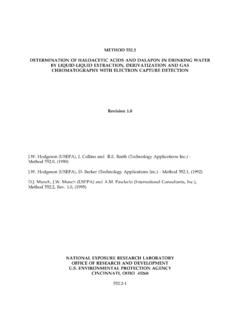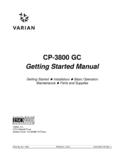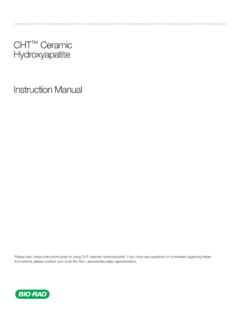Transcription of 2009 Monograph Feb 8 final - Food and Agriculture ...
1 Spirodiclofen 925 SPIRODICLOFEN (237) First draft prepared by Ms T. van der Velde-Koerts, Centre for Substances and Integrated Risk Assessment, National Institute of Public Health and the Environment, The Netherlands EXPLANATION Residue and analytical aspects of spirodiclofen were considered for the first time by the present Meeting. The residue evaluation was scheduled for the 2009 JMPR by the 41st Session of the CCPR (ALINORM 09/32/24). Spirodiclofen is an insecticide/acaricide belonging to the chemical class of ketoenols or tetronic acids, and acts as an inhibitor of lipid biosynthesis, mainly against mites. It has registered uses in many countries on fruits, fruiting vegetables, tree nuts, coffee and hops.
2 The manufacturer supplied information on identity, metabolism, storage stability, residue analysis, use pattern, residues resulting from supervised trials on grapefruit, lemons, mandarins, oranges, apples, pears, cherries, peaches, plums, blackberries, currants, grapes, raspberries, strawberries, papaya, cucumbers, gherkins, sweet peppers, tomatoes, almonds, coconut, pecans, coffee, and hops, fates of residues during processing, processing, distribution in the edible portion and livestock feeding studies. In addition, The Netherlands supplied information on use pattern. IDENTITY ISO common name: spirodiclofen Chemical name IUPAC: 3-(2,4-dichlorophenyl)-2-oxo-1-oxaspiro[ ]dec-3-en-4-yl 2,2-dimethylbutyrate CA: butanoic acid, 2,2-dimethyl-, 3-(2,4-dichlorophenyl)-2-oxo-1-oxaspiro[ ]dec-3-en-4-yl ester CAS Registry No: 148477-71-8 CIPAC No: 737 Synonyms and trade names: BAJ 2740 3-(2,4-dichlorophenyl)-2-oxo-1-oxaspiro[ 4,5]dec-3-en-4-yl 2,2-dimethylbutonate Structural formula: The active substance is not a resolved optical isomer.
3 Purity , structure confirmed by UV-VIS, FTIR (attenuated total reflection diamond single reflection unit), 1H-NMR (600 MHz, CDCl3), 13C-NMR (600 MHz, CDCl3), and LC-MS/ESI+ [Kaussmann, 2000, M-029039-02-1]. 926 Spirodiclofen OOClClOOCH3CH3CH3 Molecular formula: C21H24Cl2O4 Molecular weight: Physical and chemical properties Pure active substance Parameter Result References Guidelines/method Minimum purity: 98% [Linke-Ritzer, 2009 , M-344423-01-1] Appearance: purity white powder, no characteristic odour [Krohn, 1997, M-004681-01-1] visual olfactory Vapour pressure: purity , determination between 25 70 C 3 10-7 Pa at 20 C (extrapolation) 7 10-7 Pa at 25 C (regression analysis) Remark: The gas saturation method is only valid in the range 10-5 Pa to 103 Pa and is therefore not the appropriate method to measure such low vapour pressures.
4 Values must therefore be considered estimates. [Krohn, 1997, M-004681-01-1] OECD 104, EC A4 gas saturation method Melting point: purity C [Krohn, 1997, M-004681-01-1] OECD 102, EC A1 melt microscope Octanol/water partition coefficient: purity , at 20 C log Kow = at pH 4 (buffer not indicated) log Kow at pH 7 and 9 could not be measured due to hydrolysis of spirodiclofen at these pH values Remark: The shake-flask method is only valid in the range log Kow 2 to + 4 and is therefore not the appropriate method to measure such high log Kow values. Values must therefore be considered estimates. [Krohn, 1997, M-004681-01-1] OECD 107 shake-flask method purity , at 23 C log Kow = at pH 7 ( M K/Na-phosphate) Remark: The shake-flask method is only valid in the range log Kow 2 to + 4 and is therefore not the appropriate method to measure such high log Kow values.
5 In addition, spirodiclofen is hydrolysed at pH 7. The log Kow value at pH 7 must therefore be considered inaccurate. [Bogdoll and Wiche, 2005, M-250397-01-1] OECD 107 shake-flask method Spirodiclofen 927 Parameter Result References Guidelines/method Solubility: purity at 20 C mg/L in water at pH 4 ( M Na-citrate) water solubility at pH 7 and 9 could not be measured due to hydrolysis of spirodiclofen at these pH values [Krohn, 1997, M-004681-01-1] OECD 105, EC A6 column elution method purity at 20 C mg/L in water at pH 7 ( M K/Na-phosphate) Remark: Since spirodiclofen is hydrolysed at pH 7, the water solubility value at pH 7 must be considered inaccurate. [Bogdoll and Strunk, 2005, M-250394-01-1] OECD 105, EC A6 column elution method purity , at 20 C: n-heptane 20 g/L xylene > 250 g/L dichloromethane > 250 g/L 2-propanol 47 g/L 1-octanol 44 g/L polyethylene glycol 24 g/L acetone > 250 g/L ethyl acetate > 250 g/L acetonitrile > 250 g/L dimethylsulfoxide 75 g/L [Krohn, 1997, M-004681-01-1] CIPAC MT flask method Density: purity g/cm3 at 20 C [Krohn, 1997, M-004681-01-1] OECD 109, EC A3 ultrapycnometer Hydrolysis in water: [dihydrofuranone-3-14C] spirodiclofen, mg/L in aqueous buffer solutions with 1% acetonitrile as cosolvent under sterile conditions in the dark for 7 days at 50 C or 30 days at 25 C.
6 Calculated via Arrhenius plots: DT50 = days at pH 4 at 20 C DT50 = days at pH 7 at 20 C DT50 = days at pH 9 at 20 C In the tested pH range spirodiclofen-enol (M01) was the main hydrolysis product (28% TAR at pH 4, 52% TAR at pH 7 and 101% TAR at pH 9 at 25 C). Further hydrolysis products were not relevant (< 2% TAR) [Babczinski, 2000a, M-039584-01-1] EPA 161-1, 95/36/EC Photolysis in water: [dihydrofuranone-3-14C] spirodiclofen, as mg/L in aqueous buffer solution containing 20% acetonitrile and irradiated by a xenon lamp during 19 days. DT50 = days at pH 4 at 25 C Spirodiclofen degraded to TAR at 19 days. The main degradation product was carbon dioxide ( TAR at day 19). Further degradation products did not exceed TAR.
7 In a supplementary test using [cyclohexyl-1-14C] spirodiclofen the results of the main test were confirmed. Remark: Because pH during the main experiment ranged from to , part of the degradation might have been caused by hydrolysis. The half-life must be considered an estimate. [Stupp and Brumhard, 2000, M-031270-01-1] EPA 161-2 Dissociation constant: From the chemical structure of spirodiclofen it can be deduced that a pKa cannot be determined in aqueous media. [Linke-Ritzer, 2005, M-250824-01-1] 928 Spirodiclofen Technical material (active substance as manufactured) Parameter Result References Guidelines/method Minimum purity [Linke-Ritzer, 2009 , M-344423-01-1; Bayer CropScience, 2009a, M-344196-01-1] Main impurities: no data submitted (confidential data) Appearance: purity colourless to light brown solid, weak characteristic odour [Bayer CropScience, 2009a, M-344196-01-1] visual olfactory Relative density: purity g/cm3 at 20 C (experimental conditions not stated) [Bayer CropScience, 2009a, M-344196-01-1] not stated Melting range: purity C (experimental conditions not stated) [Bayer CropScience, 2009a, M-344196-01-1] not stated Stability in air purity Thermally sTable at ambient temperature under air.
8 DTA measurement: no exothermic reaction until 350 C TGA measurement: a weight loss of 100% was observed at 160 C [Krohn, 1997, M-004681-01-1] OECD 113 Formulations Spirodiclofen end-use products are formulated as suspension concentrate (SC and 240 g ai/L), wettable powder (WP 360 g ai/kg) or as water dispersible granule (WG 380 g ai/kg). FAO specifications for technical and formulated spirodiclofen have not been published. Abbreviations The following abbreviations are used throughout the review Code Full name ACN acetonitrile ai active ingredient = active substance (in this review spirodiclofen unless specified otherwise) APCI atmospheric pressure chemical ionisation (for MS detection) CEC cation exchange capacity cm centimetre ( m) CO2 carbon dioxide d days DAT days after (last) treatment DCM dichloromethane DT50 period required for 50% dissipation: 50% of the parent has disappeared.
9 Also called half-life. dw dry weight eq residues expressed as spirodiclofen equivalents ESI electron spray ionisation (sample introduction/ionisation technique for MS) EtOAc ethyl acetate Spirodiclofen 929 Code Full name FTIR Fourier transformed infrared spectroscopy GC-ECD gas chromatography with electron capture detection GC-MS gas chromatography with mass spectrometric detection GPC gel permeation chromatography HCl hydrochloric acid HPLC high performance liquid chromatography HPLC-DAD high performance liquid chromatography with diode array detection HPLC-MS high performance liquid chromatography with mass spectrometric detection HPLC-MS-MS high performance liquid chromatography with tandem mass spectrometric detection HPLC-UV high performance liquid chromatography with spectrophotometric detection (at ultra violet wavelength)
10 Hr hour kg ai/ha kilogram active ingredient per hectare (1 hectare = 10000 square metres) L/ha litre per hectare (1 hectare = 10000 square metres) LOQ limit of quantification = limit of quantitation = limit of determination LSC liquid scintillation counting of radioactivity M molar = mole/L MeOH methanol mg ai/kg bw/d milligram active ingredient per kilogram bodyweight per day mg ai/kg dw milligram active ingredient per kilogram dry weight (usually feed or soil) mg/kg eq milligram per kg, expressed as spirodiclofen equivalents MRL maximum residue limit m/z mass to charge ratio (mass unit for mass spectrometry) NaCl sodium chloride NaOH sodium hydroxide NMR nuclear magnetic resonance r correlation coefficient (in regression analysis) r2 or R2 coefficient of determination (in regression analysis) RAC raw agricultural commodity RSDr precision under repeatability conditions (measurements within one day or one run) expressed as relative standard deviation (= coefficient of variation) SO2 sulfur dioxide SPE solid phase extraction RR recovered radioactivity in whole animal or whole plant TAR total applied radioactivity (crops) or total administered radioactivity (livestock) TLC thin layer chromatography TRR total radioactive residue in specified plant part or animal part UV-VIS absorption spectrometry in ultraviolet and visible part of the spectrum % v/v percentage volume:volume (mL/100 mL) v/v mixing of solvents on volume basis ( , 80:20 v/v = 80 mL.)















